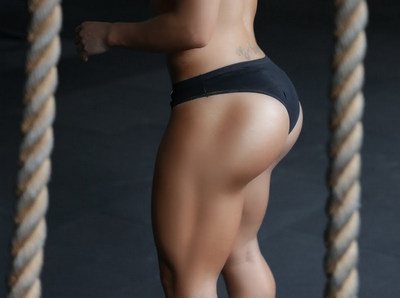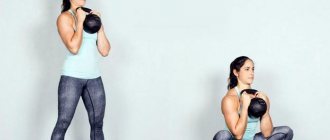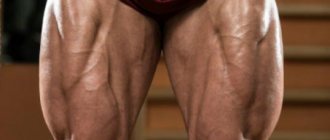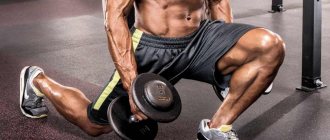Testosterone production when doing squats
The legs are the LARGEST muscle group in our body.
Performing leg exercises requires a huge amount of effort, energy and recovery capacity.
Leg training is always a HUGE STRESS for the body. After all, almost the entire body is involved in this process.
The muscles of the legs (of course), core, back, arms, etc. become tense.
Blood circulation in the lower part of the body increases, which leads to stimulation of the sex glands (in men), which then leads to the production of a huge amount of ANABOLIC HORMONES (testosterone, primarily).
Almost always, anabolic hormones are released in excess, which is enough for the restoration and growth of other parts of the body.
Especially, this is very useful for athletes who train naturally. Indeed, it is in this case (when you train without steroids and other stimulants) that the production of your OWN testosterone plays a leading role.
We must try with all our might to create a favorable anabolic background for the body to grow.
Squat technique with a barbell on the shoulders (classic squats)
This is an extremely important question, friends!
It is when performing squats with a barbell on the shoulders that the cost of error is extremely high. I can't even imagine a more dangerous exercise in bodybuilding.
Although, any exercise can become dangerous if you turn off your brain. Figuratively speaking, naturally.
Starting from ruptures of the spinal extensors, to fractures of the neck, knee joints and death (!). All this can happen if a person “put” on technique from the very beginning of his training.
That is why I ALWAYS advise that the first two to three months be paid attention to the MOST IMPORTANT period in a person’s entire future training life - the period of preparation for further hypertrophy.
Without this, everything can, sooner or later, end very badly.
There is still a chance of injury, it still remains, but you significantly reduce the risk if you perform the exercises with perfect technique.
So, how to do squats correctly:
- We approach the squat rack (as a rule, there are limiters there, install them, they give additional confidence).
- We grab the bar slightly wider than shoulder width.
- Place the bar just above the delts and just below the trapezoid.
- Strain and straighten your back, remove the bar from the racks. Attention: While performing squats, your feet must be pressed to the floor ENTIRELY!!! There should be no calf raises!!!
- We keep our heads either straight or look up. This will allow us to keep our back straight at every point of the amplitude!
- We place our feet slightly wider than our shoulders, with our toes pointing forward (you can turn them outward by 15-20 degrees).
- The back is straight, the head looks straight or up, we begin to bend the legs.
- We squat either until our thighs are parallel to the floor, or slightly lower.
- WE FEEL THE CONTRACTION AND TENSION OF OUR QUADRICEPS, we begin to move upward.
- We strain our quadriceps, straight back, look up or straight, stand up, constantly thinking about how the quadriceps feel. You must feel them AT EVERY POINT OF AMPLITUDE, otherwise, otherwise, the load may not hit the target exactly, but will “spread” over the back, buttocks and other muscles.
The simplest manipulations with squats:
- BREAK YOUR LEGS WIDER = the inner thighs work harder.
- BRINGING THE LEGS ALREADY = the lateral (outer) heads of the quadriceps are more involved in the work.
- LEANING A LITTLE STRONGER FORWARD = emphasis shifts to the gluteal muscles.
- KEEP YOUR BACK EVEN = the load falls on the quadriceps.
- TURN YOUR FEET OUTSIDE = shift the load to the lateral heads of the quadriceps.
- FEET STRAIGHT = load is distributed evenly across all heads of the quadriceps (lateral, medial, rectus and intermediate).
Under no circumstances should you:
- Push your knees forward beyond your toes . This can lead to rupture of ligaments, menisci and other unpleasant consequences.
- Bend your back at any point of the amplitude . If this trick is performed with a large enough weight, then you will have to say goodbye to barbell squats forever, and to normal training too. Can lead to rupture of spinal extensors, vertebral injuries, etc.
- Lean back too much . This will lead to a simple loss of balance and, most likely, injury.
These are the most classic squats, with which you can grow very impressive leg muscles.
How to squat correctly to pump up your legs
This article will present the most effective exercises to pump up your legs with squats. You will learn how to squat correctly with and without a barbell, dumbbells (weights). Every self-respecting bodybuilder should be able to squat correctly
Squats
Muscles: Glutes, hamstrings, quads, calves, abs.
- Starting position: feet shoulder-width apart. Place the barbell on your shoulders if your form allows, or pick up dumbbells.
- Bend your knees and hips at the same time, lowering yourself down. Stop when your thighs are parallel to the floor, but you can go lower if you feel no difficulty.
- Straighten your knees and return to the starting position.
NOTE. Always keep your back straight; the projection of the knees should not extend beyond the toes.
Step up with and without dumbbells
Get ready to step up to the heights of bodybuilding with toned legs.
Muscles: Gluteal, hamstrings, quadriceps, shoulders, abs.
- Starting position: feet shoulder-width apart, facing a bench or platform approximately 30-90 cm high. If you feel sufficiently prepared, take dumbbells in your hands and press them to your sides.
- Step up, lifting your right knee, and place your foot on the bench. Straighten your right leg and push your whole body up.
- Return to the starting position and repeat the movement with your left leg. So you took the first steps towards legs that look decent in the shortest shorts.
Barbell Lunge
Lunging like crazy is perhaps the healthiest way to get insanely muscular legs.
Muscles: Glutes, hamstrings, quads, calves, abs.
- Starting position: feet hip-width apart. Place the barbell on your shoulders if you are prepared enough, or pick up dumbbells.
- Take a giant John Cleese-style step forward with your right foot. The right thigh should be parallel to the floor.
- Return to the starting position. Be careful not to fall when you start to get tired; it will happen very soon. Balance on one leg is not easy. Repeat the same with your left leg; soon your legs will be strong enough to hike to the Sahara and back.
Barbell Lunge Squat
Pumped up arms are inexpensive if not balanced by a pair of equally toned up legs.
Muscles: Quadriceps, glutes, hamstrings, abs.
- Lunge with your right foot forward. Place the barbell on your shoulders if you are prepared enough, or pick up dumbbells.
- Bend both knees so that the back one just barely touches the floor. Return to the starting position.
- Change the position of your legs and repeat. Starting your car using a pushrod will soon no longer be a problem for you.
Leg press
Build the teardrop muscles above your knees that make your bike go faster.
Muscles: Quadriceps, glutes, hamstrings, calves.
- Climb into the leg press machine and take on the machine so John Connor can make an example of you. Press your buttocks and back against the backrest, rest your feet hip-width apart on the platform above.
- Press the weight up, straightening your legs. Don't overextend your knees.
- Release the support and slowly lower the weight until your legs are bent at a 90° angle. Straighten your legs again, but don't overextend them.
Leg extension on the simulator
It's time for another man versus machine battle. After winning this battle, you will have enough strength to kick the ball into the opponent's goal across the entire field.
- Sit on the leg extension machine, placing your buttocks flat on the seat. Hook your feet onto the roller.
- Slowly extend your legs up and forward until fully extended, but do not overextend your knees.
- Pause, then slowly bend your knees and lower your legs.
Squat Lunge with Jump
This leg strength exercise, when done correctly, can make your scrotum jump out of your workout shorts. Be especially careful if you prefer to exercise in jogging shorts.
Muscles: Quadriceps, glutes, hamstrings, calves, core.
- Stand in a lunge position, right leg in front, left leg behind, knees slightly bent. If you want, take small dumbbells or weights in your hands and press them to your sides.
- Bend your knees and jump up. Change the position of your feet in the air and land with your left foot in front.
- Bend your knees as you land to soften the impact.
NOTE. If you have problems with your knees, work only with your own weight.
Calf Raise
The hamstrings are not the muscles whose shape and size you usually show off to your friends, but they are the ones that bear the responsibility when you are passing your opponent on the sports field. So you'll probably want to tense them up in public.
Muscles: Hamstrings, gluteals.
- Lie down on the hamstring exercise machine with your body pressed against the platform. Ankles under the bolster.
- Bend your legs and pull the roller towards your buttocks.
- Lower the roller to its original position for 3-4 seconds. This exercise is very difficult to do incorrectly because the machine only works in one way.
Deadlift for legs
This leg strength exercise will keep you on your feet even when your less fit peers are hobbling around in walkers.
Muscles: Hamstrings, lower back, abs.
- The technique for performing the leg exercise is almost the same as for a traditional deadlift; the only difference is that the knees remain straight (in no case overextended) during the movement. Place the barbell in front of you and grab it with an overhand grip.
- Straighten your back and lift the barbell. Keep her as close to you as possible.
- Within 2-3 seconds, lower the bar to its original position. This will strengthen and stretch your hamstrings, which will be useful for you on the sports field, and will also help you master a couple of new positions in the bedroom.
Powerlifting barbell squats (sumo squats)
They are not much different from regular squats, but they are the BEST EXERCISE for increasing the mass of the gluteal muscles (for girls, this is generally the best exercise, in principle).
In another way, this type of squats is called: sumo squats.
Indeed, if you look from the outside, the body position is very similar to how sumo wrestlers begin their fights, the only difference being that during such squats our hands are not on our hips, but on the bar.
This is an excellent type of squat that minimizes the risk to the knee joints (since the legs are placed wider, and part of the load is shifted to the buttocks, and to another large muscle group - the back).
Because As the load is partially shifted to your back, the requirements for stability of your back, and in particular your lower back, increase. Be sure to add hyperextension (as if you are pumping your abs in reverse) to your workouts to strengthen your lumbar region.
Sumo squat technique
- We approach the squat rack (as a rule, there are limiters there, install them, they give additional confidence).
- We grab the bar with a fairly narrow grip (thumbs slightly wider than shoulders).
- We place the bar ON YOUR BACK, usually 80-120 millimeters lower than with regular squats.
- Strain and straighten your back, remove the bar from the racks. Attention: While performing squats, your feet must be pressed to the floor ENTIRELY!!! There should be no calf raises!!!
- We keep our heads either straight or look up. This will allow us to keep our back straight at every point of the amplitude!
- We place our feet 100-150 millimeters wider than our shoulders. The toes point outward at 45 degrees (i.e., figuratively, our feet should form a right angle).
- The back is straight, the head looks straight or up, we begin to bend the legs.
- We move the pelvis down and BACK, while simultaneously bending the legs at the knees (the knees do not go beyond the toes). We tilt the body slightly forward.
- We squat either until our thighs are parallel to the floor, or slightly lower.
- The body at the lowest point is tilted approximately 45 degrees, the back is PERFECTLY FLIGHT, the pelvis is laid back.
- THE LOAD SHOULD RESIST ON THE HEELS OF THE FEET, not on the toes.
- WE FEEL THE CONTRACTION AND TENSION OF OUR QUADRICEPS, we begin to move upward.
- We strain our quadriceps, straight back, look up or straight, stand up, constantly thinking about how the quadriceps feel. You must feel them AT EVERY POINT OF AMPLITUDE, otherwise, otherwise, the load may not hit the target exactly, but will “spread” over the back, buttocks and other muscles.
For those who are asking how to quickly pump up your buttocks by doing just one exercise, here is your answer - DO SUMO STYLE SQUATS.
Which squats and in what quantity are most effective for the gluteal muscles?

It’s no secret that the beautiful shape of a woman’s butt affects both guys and older men no worse than the red banner of a bullfighter affects a bull. And absolutely regardless of whether these nut-shaped and toned buttocks are covered in denim shorts from a sale or a dress from Armani. This is how nature decreed it - whether someone likes it or not. Obviously, working on this part of the body is very important for girls and women. But not all of them are ready to immediately sign up for a gym and gruelingly work with a barbell. Is it possible to get by with cheaper and simpler means? It turns out that it is possible! And the main one of these means is called “squats”. But how much do you need to squat to pump up your buttocks? How often and with what load should I do this? Use one or more variations of this exercise? And is it necessary to combine this with proper nutrition? Let's start answering the questions posed in order.
Partial squats (partial squats)
This type of squats has several significant positive aspects.
When performing partial squats, the load on the back and knee joints is reduced (since the angle between the hips and calves is greater).
I also saw how powerlifters used this type of squats to break through their so-called. "psycho-emotional ceiling" That moment when you are afraid to take on new weight, because... you think you can't stand it.
These squats, in such cases, come in handy.
It is best to perform them either in a Smith machine (in a power rack).
Or in regular squat racks, but with high-mounted stops that will serve as support. If something goes wrong.
Partial squat technique
It’s no different from regular squats, the only difference being that you squat not to parallel, but a little higher.
Partial squats can be performed either classic style (a little more dangerous) or sumo style (less dangerous).
About the number of daily squats
Finally, we move on to the main question of our topic - how many squats per day should you do to properly pump up your buttocks?
Their number should be increased gradually.
- Week 1 – 6 sets of 5 squats each (30 in total).
- Week 2 – 5 sets of 10 squats each (50 in total).
- 3–4 weeks – 5 sets of 15 squats each (75 in total).
- 1–3 months – 4 sets of 30 squats of different types (120 in total).
- 3–6 months – 4 sets of 35 squats of different types, including with weights (140 in total).
- 1 year – 4 sets of 40 squats of different types with more massive weights (160 in total).
With such training experience, it would be optimal to add other types of exercises to squats. We recommend reading the article “What exercises will help build up your gluteal muscles?”
Front Squats
Or a front squat.
It’s good because it focuses the load strictly on your quadriceps and makes it much easier to maintain balance (the main weight is in front, while moving the body back).
There is a slight downside in that you have to hold your hands in an awkward position to hold the barbell, but over time you will get used to it.
Front squat technique
- We approach the squat rack (as a rule, there are limiters there, install them, they give additional confidence).
- Bring your shoulders under the bar. We cross our arms and grab the bar.
- We place the bar just below your deltoids, almost above your biceps.
- We remove the bar and take a step back.
- We strain and straighten our back. Attention: When performing front squats, your feet must be pressed to the floor ENTIRELY!!! There should be no calf raises!!!
- We keep our heads either straight or look up. This will allow us to keep our back straight at every point of the amplitude!
- We place our feet slightly wider than our shoulders, with our toes pointing forward (you can turn them outward by 15-20 degrees).
- The back is straight, the head looks straight or up, we begin to bend the legs.
- We squat either until our thighs are parallel to the floor, or slightly lower.
- WE FEEL THE CONTRACTION AND TENSION OF OUR QUADRICEPS, we begin to move upward.
- We strain our quadriceps, straight back, look up or straight, stand up, constantly thinking about how the quadriceps feel. You must feel them AT EVERY POINT OF AMPLITUDE, otherwise, otherwise, the load may not hit the target exactly, but will “spread” over the back, buttocks and other muscles.
Muscles of the back of the thigh: “Squat, but don’t forget about the deadlift?”
Fitness professionals know that squats are very effective for developing the quadriceps, adductor magnus and gluteus maximus muscles, but are not very effective for developing the hamstrings (Wright et al. 1999).
This is why a variety of deadlift variations (plus other exercises) are always included in a good training program to target the posterior chain muscles (those located on the back of the body)*.
To support the opinion that squats are incapable of properly loading the muscles of the hamstrings, we present the following data:
- Increasing the weight on the barbell in the squat does not increase hamstring activation , but does significantly increase quadriceps and gluteus maximus activation (Li et al. 2013).
- Lowering into a deeper squat with the same load does not increase hamstring activation , but does increase quadriceps and gluteus maximus activation much more (Gorsuch et al. 2013; Contreras et al. 2015b).
Smith machine squats
These squats are different in that the problem with stabilizing movements is COMPLETELY eliminated. You move along a strict trajectory dictated to you by the simulator.
This allows you to move your feet much further forward to shift the load on your gluteal muscles.
Nothing special about technology. As with most regular squats, only before starting the movement you will need to rotate the bar slightly around its axis to remove it from the hooks and begin the movement.
Before finishing the approach, you need to do the same thing, only in the opposite direction (to put the bar in place).
You can do a wide variety of exercises at Smith.
The most concentrated and one of the best exercises for the gluteal muscles is the following exercise.
What do experts recommend remembering first?
- You should start squats after a short warm-up. In our case, it includes a slight rotation of first the ankle, then the foot of one leg, and then the other. It is necessary to make at least 8–10 rotational movements.
- In most squat methods, you need to rest on your entire foot, without lifting up on your toes.
- The back should always remain straight.
- While doing squats, keep your abdominal muscles tense. Thus, in parallel with training the gluteal muscles, you will achieve a small loss of fat from the abdomen, and also strengthen the muscle corset in the back and lower back.
- Don't try to do too many squats per unit of time. Medium pace is not only safer, but also more effective.
- Breathe evenly, lowering with a slow inhale and rising with a full exhale.









